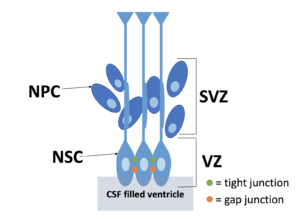Research 101: Brain Development
By: Noriana Jakopin and Dr. Jenna Koschnitzky, HA Director of Research Programs
The Ventricular Zone and the Subventricular Zone
Where Are They Located?
The ventricular zone (VZ) and the subventricular zone (SVZ) are located at walls of the lateral ventricles in developing fetuses.
What Are They?
The VZ and SVZ are layers of embryonic tissue which act as a source for most mature neurons. The VZ and SVZ are composed of cells which are undifferentiated, meaning the final function of the cell has not been determined.

The ventricular zone (VZ) is composed of neural stem cells (NSCs). NSCs in the VZ are long cells partially submerged in cerebrospinal fluid (CSF). They are the cells from which all neurons originate. NSCs continuously divide to form more NSCs. The NSCs also can differentiate into, or become, ependymal cells, which are the cells that line the ventricles.
During brain development, a NSC divides into two different types of cells. One cell remains a NSC and the other becomes a neural progenitor cell (NPC).
NPCs are the cells that form the subventricular zone (SVZ). The SVZ is the first site of neurogenesis whereby the cell matures and becomes the target cell, or the final cell type. NPCs in the SVZ use the long axons of the NSCs as scaffolding for migration, an integral part of neurogenesis. Neural migration is when a cell travels to its final destination where it will remain and work as a fully functional neuron.
As you can see, NCSs and NPCs are extremely important for normal brain development.
Why is this Important to Hydrocephalus?
Recent research had concluded that abnormal cell junctions in the VZ leads to VZ disruption. The disruption of the VZ results in two inseparable phenomena: loss of ependymal cells which eventually leads to hydrocephalus and loss of NSCs and NPCs which leads to abnormal neurogenesis. It is hypothesized that abnormal neurogenesis as a result of VZ disruption causes the irreversible neurological impairments which accompany hydrocephalus. This will be further explained in the next installment of this blog series.
